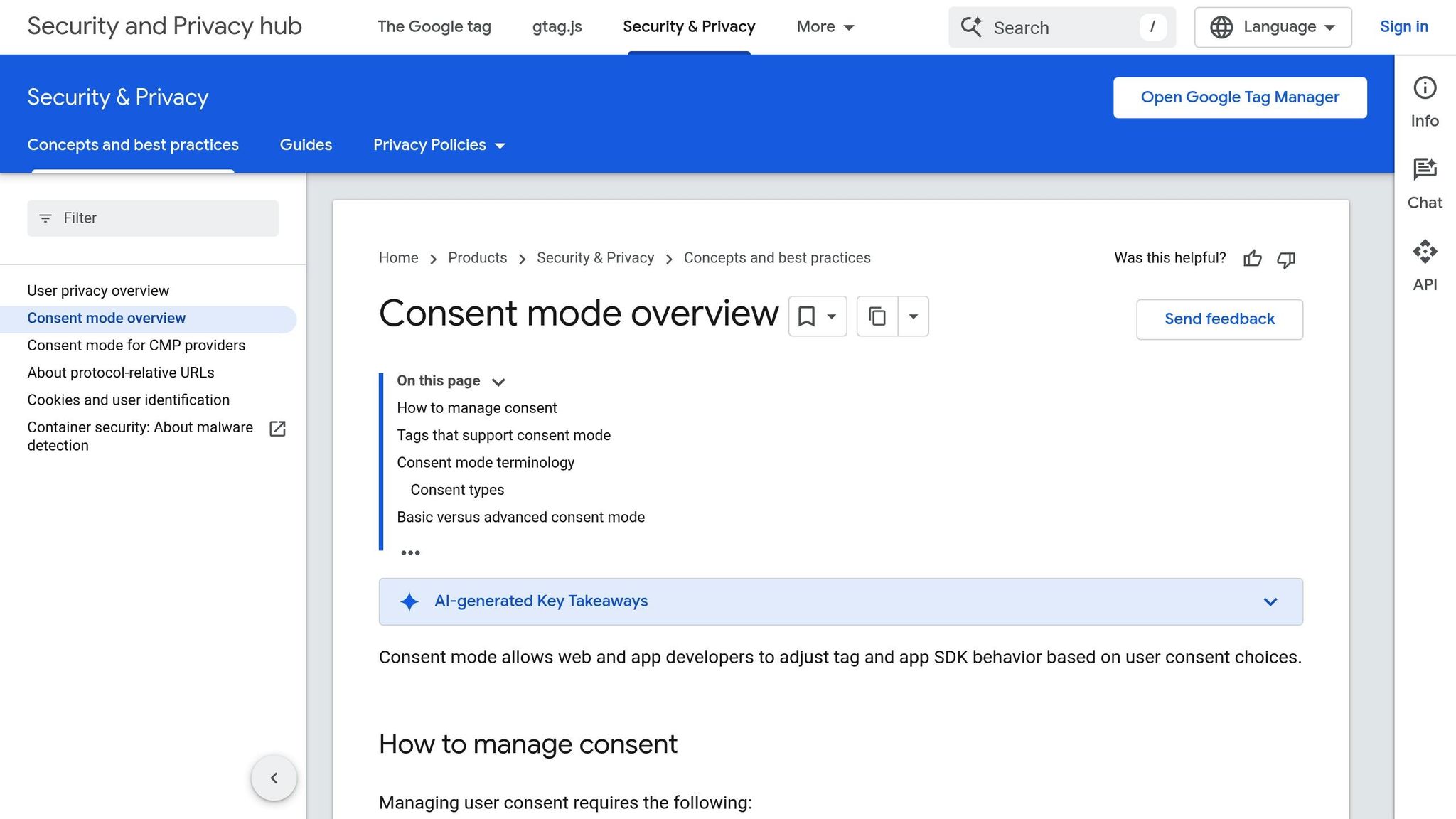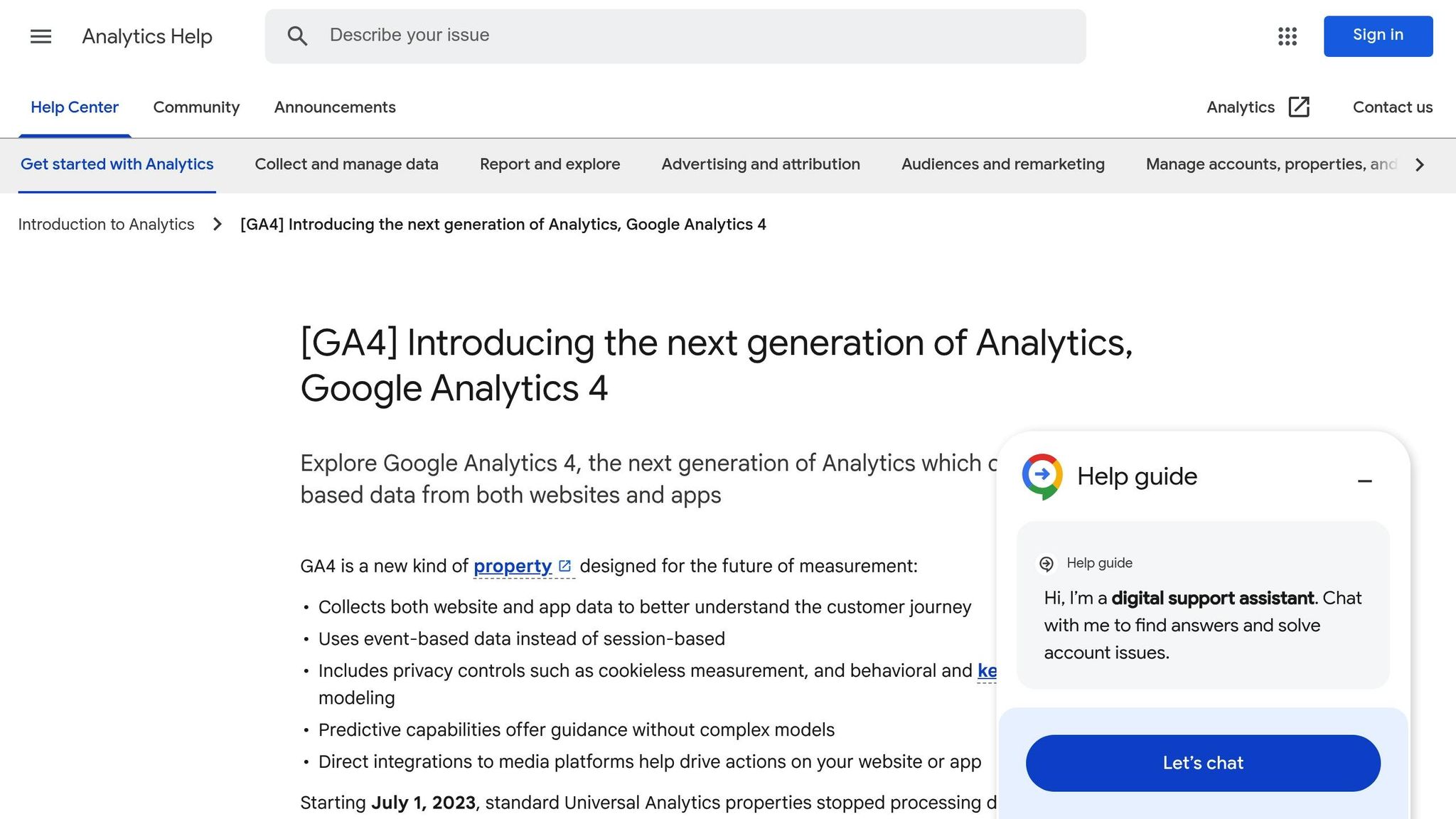How Consent Mode Affects Marketing Automation

Consent Mode reshapes how marketers collect and process data, balancing user privacy with campaign performance. It adjusts tracking based on user consent, using anonymized data and conversion modeling to fill gaps when users opt out. This ensures compliance with privacy laws like GDPR and CCPA while maintaining analytics and automation workflows.
Key takeaways:
- What it does: Consent Mode modifies data collection based on user preferences, limiting personal data tracking for non-consenting users.
- Why it matters: It helps marketers comply with privacy laws while using anonymized data to estimate conversions and optimize campaigns.
- Challenges: Data loss, disrupted workflows, reduced personalization, and technical complexity.
- Solutions: Use tools like GA4, conversion modeling, and consent management platforms to maintain performance and compliance.
Marketers need to adapt workflows, refine bidding strategies, and build segments based on consent preferences to succeed in this privacy-first era.
Google Consent Mode v2 - Everything You Need to Know

How Consent Mode Disrupts Marketing Automation
Consent Mode shakes up marketing automation workflows by fundamentally altering how data flows through your systems. This shift can create significant gaps, even in the most carefully crafted campaigns.
Limited Data Collection
Consent Mode restricts data collection based on user consent preferences, which means platforms like Google Ads and Google Analytics lose access to detailed behavioral and conversion data from users who deny consent. Instead of receiving a complete breakdown of user interactions, marketers are left with aggregated or anonymized data. This lack of detail hampers the ability to gain precise insights needed for optimizing campaigns.
When users opt out of tracking, critical data - like page views, click patterns, time spent on site, and conversion paths - disappears. This creates blind spots in understanding the customer journey, a cornerstone of effective marketing automation.
For businesses using tools like Reform, these limitations are particularly noticeable. Without user tracking, it becomes harder to analyze form completion rates, identify where users drop off, or follow their journey from form submission to conversion. Features like lead enrichment and real-time analytics may be forced to rely on incomplete datasets, making it tougher to fully optimize performance.
These missing details set the stage for significant challenges in automated campaigns and analytics.
Problems with Automated Campaigns
Data gaps caused by Consent Mode ripple through campaign automation channels. Retargeting, personalization, and machine learning optimization all take a hit when user data is incomplete. For example, remarketing lists shrink when a portion of visitors decline consent for advertising cookies, limiting the reach of re-engagement efforts.
Automated bidding strategies also struggle without essential conversion signals. Machine learning algorithms that drive smart bidding depend on robust datasets to predict user behavior and optimize ad placements. When conversion data from non-consenting users is missing, these systems can misjudge performance, leading to wasted ad spend and lower ROI.
Personalization tools face similar hurdles. Without complete data, automated email sequences, dynamic website content, and targeted offers lose their accuracy. Imagine a user who previously browsed specific product categories but declined tracking - personalization algorithms will fail to recognize their preferences, resulting in generic, less effective experiences.
The financial impact is hard to ignore. Brands that have seen a 20% drop in consent acceptance rates over two years report major disruptions to their automated campaigns. However, those using Consent Mode alongside conversion modeling have managed to recover much of the lost data.
Effects on Analytics Platforms
Consent Mode also creates significant gaps in analytics reporting. These gaps lead to incomplete reports, misattributed sessions, and less reliable performance metrics - issues that directly affect the decision-making processes of marketing automation systems.
Google Analytics, a go-to tool for many marketers, often shows dramatic changes when Consent Mode is introduced. In one case study, a company reported a 15% increase in organic traffic attribution. This wasn’t because their organic performance improved but because previously misattributed sessions were reclassified under the new consent rules.
CRM integrations also take a hit. Tracking user journeys and accurately attributing lead sources becomes more difficult. This affects key processes like lead scoring and nurturing, disrupting everything from automated email campaigns to how sales teams prioritize leads.
| Impact Area | Without Consent Mode | With Consent Mode |
|---|---|---|
| Data Completeness | Full user tracking | Gaps for non-consenting users |
| Attribution Accuracy | Often inflated or misattributed | Cleaner but with gaps |
| Automation Effectiveness | High precision with complete data | Reduced precision; relies on modeling |
These analytics challenges make it hard to compare metrics from before and after Consent Mode implementation, creating additional complications for platforms focused on conversion optimization. For instance, inconsistent form tracking due to varying consent preferences makes it harder to identify which designs or workflows are driving the best conversion rates.
Solutions for Marketing Automation with Consent Mode
With data limitations posing challenges, these solutions work effortlessly with existing marketing automation tools, helping maintain campaign performance while upholding privacy and compliance standards.
Using Advanced Mode for Better Data Collection
Advanced Mode is a smart way to address gaps in data collection. It activates Google tags before users provide consent, sending cookieless pings that create anonymized signals for conversion modeling. Even when users opt out of tracking, these tags still transmit anonymized data, enabling Google to fill in the blanks and provide a clearer view of campaign performance.
Businesses that adopt Advanced Mode often see better data attribution, as highlighted in various case studies. For example, tools like Reform can leverage this feature to enhance their real-time analytics and lead enrichment capabilities. By tapping into modeled data, businesses gain accurate insights into user behavior and form completion rates without compromising user privacy.
Using Conversion Modeling
Conversion modeling steps in to estimate conversions and predict user actions using anonymized data. It relies on aggregated information from consenting users to infer behavior patterns for those who decline tracking. When paired with high-quality lead capture tools, conversion modeling becomes even more effective at bridging data gaps. Platforms like Reform contribute to this process by generating richer datasets, improving the accuracy of predictions for non-consenting users.
Coordinated Consent Management Across Platforms
Coordinating consent management ensures that data flows smoothly across all marketing and analytics platforms. This involves aligning consent categories with each platform's specific requirements. For instance, advertising preferences for Google Ads should mirror those in Meta Ads Manager, while analytics consent settings need to be consistent across tools like GA4 and your CRM system.
| Platform Type | Consent Categories | Integration Requirements |
|---|---|---|
| Advertising (Google, Meta) | Ad personalization, remarketing | Consent signals, audience syncing |
| Analytics (GA4, Adobe) | Performance measurement, behavior tracking | Session-level consent, attribution modeling |
| CRM/Marketing Automation | Lead tracking, email marketing | Contact-level preferences, segmentation rules |
Form builders like Reform are essential in this process. They capture consent preferences at the very first interaction - during lead generation. With tight integrations into marketing and CRM tools, this consent data flows seamlessly from the initial form submission through every stage of the customer journey. This ensures that automation workflows respect user preferences while maintaining compliance. By adopting these strategies, businesses can use consent-driven data to enhance their automation efforts without overstepping privacy boundaries.
sbb-itb-5f36581
Improving Marketing Automation for Consent-Based Data
Adjusting to consent-based data requires a thoughtful approach to tools, bidding strategies, and audience segmentation. The objective? To keep campaigns effective while respecting user privacy and adhering to regulations.
Transitioning to GA4 and Consent-Compatible Tools

Google Analytics 4 (GA4) is built with privacy regulations in mind and integrates seamlessly with Consent Mode. This setup allows for essential data collection even when users opt out of tracking. GA4 uses conversion modeling to fill in the gaps left by non-consenting users by analyzing patterns from consenting users and estimating the missing conversions. This keeps audience segments functional and ensures remarketing campaigns can still run effectively, even with limited direct data.
GA4 also offers improved attribution accuracy, giving marketers better insights into which channels are driving conversions. This cleaner data makes it easier to allocate budgets strategically.
To fully embrace consent-based workflows, ensure your tech stack is up to the task. For example, tools like Reform simplify consent capture during lead generation, feeding this data directly into your CRM and marketing automation platforms. With analytics tailored for consent-based data, it’s also crucial to adjust your bidding strategies to align with these changes.
Adjusting Bidding Strategies for Modeled Data
When relying on modeled data, traditional bidding strategies that depend on precise conversion tracking may falter. Instead, strategies like Target CPA (Cost Per Acquisition) and Target ROAS (Return on Ad Spend) are better suited for this environment. These approaches use machine learning to optimize outcomes, even when conversion data is based on estimates rather than exact numbers.
During the transition, closely monitor your campaigns and be ready to tweak your target CPA or ROAS. Businesses often find that optimal CPA targets might need to rise by 10–15% to account for the variability in modeled data. Alongside these adjustments, refining audience segmentation based on consent levels can further improve campaign performance.
Building Audience Segments Around Consent Preferences
Audience segmentation becomes more reliable when based on explicit consent. Users who actively share their data tend to form segments with higher engagement and conversion rates, making them ideal for targeted marketing efforts.
Consider dividing users into three main groups:
- Full Consent: These users allow complete tracking, including analytics and advertising. They’re prime candidates for personalized campaigns and detailed remarketing.
- Partial Consent: Users in this group permit only analytics tracking. Broader targeting and content-driven campaigns work well here.
- No Consent: For these users, only modeled data is available. Focus on generic messaging and brand awareness strategies.
| Consent Level | Available Data | Recommended Strategy |
|---|---|---|
| Full Consent | Complete tracking, behavioral data | Personalized campaigns, detailed remarketing |
| Partial Consent | Analytics data, limited advertising | Broader targeting, content-focused campaigns |
| No Consent | Modeled data only | Generic messaging, brand awareness focus |
Full-consent users are your most valuable audience. Use your most advanced automation workflows and personalized messaging to engage this group. For partial-consent users, rely on analytics data to understand their preferences and behavior, while employing broader marketing tactics. Even the no-consent group can be effectively reached with general messaging and brand-building initiatives, thanks to modeled data.
To stay effective, keep these segments updated. User preferences can change, so set up automated workflows to periodically reassess consent statuses. This ensures your campaigns remain compliant while making the most of each user’s chosen level of data sharing.
Measuring Consent Mode's Impact on Marketing Automation
After addressing data gaps, the next step is to measure how well Consent Mode is working for your marketing automation efforts. This involves tracking specific metrics and comparing performance over time. Without this measurement, it’s impossible to know if your privacy-compliant strategies are effective or need tweaking.
Key Metrics to Track
One of the most important metrics to monitor is conversion modeling accuracy. This compares predicted conversions from users who didn’t give consent with actual conversions from those who did. For high-traffic sites (10,000+ monthly conversions), accuracy typically falls between 85-95%. However, smaller sites may see lower accuracy due to limited data, making statistical analysis more challenging.
Start by creating a control group of users who fully consent. Use this as a benchmark. If your cost-per-acquisition (CPA) and return on ad spend (ROAS) remain steady - or even improve - after implementing Consent Mode, it’s a good sign that the modeling is working as intended.
Attribution improvements are another key area to watch. For instance, one company using Google Consent Mode v2 through OneTrust reported a 43% drop in direct traffic, a 15% rise in organic traffic, and a 68% decline in unassigned traffic. These shifts point to better data accuracy and session reassignment, not actual traffic loss.
Next, evaluate campaign efficiency metrics. Keep an eye on CPA and ROAS across all campaigns, especially those using automated bidding. Track how many of your total conversions come from modeled data versus actual data collection. Typically, modeled conversions account for 20-40% of the total, depending on your consent rate.
Audience segment performance also plays a critical role. Consent Mode helps build audience segments using aggregated, anonymized data. Monitor the size and growth of remarketing, lookalike, and custom audiences. Check whether these segments are maintaining or expanding despite privacy limitations.
Lastly, assess data completeness. This shows how much of your reporting relies on actual user actions versus modeled predictions. Measure the percentage of traffic with complete conversion data to ensure your automation workflows remain reliable. Adjust targeting and messaging as needed based on these insights.
These metrics collectively help connect the dots between the challenges you face and the solutions you’ve implemented.
Comparing Before and After Implementation Data
To measure the true impact of Consent Mode, you’ll need a solid baseline. Start by documenting key metrics - like conversion counts, traffic sources, and audience segment sizes - for 30 to 60 days before implementation. This data will serve as your control group for meaningful comparisons.
Audit your current consent rates and tracking data by traffic source and user type. This will make it easier to analyze changes later.
Immediate changes often become visible within 24 to 48 hours as the system begins collecting consent signals. During the first week, you may notice shifts in traffic attribution as previously misattributed sessions are reassigned to their correct sources. However, avoid making major campaign adjustments during this time. Conversion modeling usually requires 7 to 14 days of data collection to reach statistical significance.
Performance stabilization generally occurs within 30 days. By this point, metrics like CPA and ROAS should level out, allowing you to confidently compare them against your baseline. For lower-traffic sites, this process may take an additional week or two.
It’s also important to distinguish between actual performance drops and reporting artifacts. For example, if reported conversions drop by 20-30% but revenue remains stable, it’s likely that Consent Mode is correctly attributing conversions that were previously misclassified or untracked.
Recovery rates depend on how well Consent Mode is implemented. With a proper setup, marketers can regain 70-90% of data lost due to users declining consent. In one case, a brand managed to recover nearly all of the 20% of data lost from lower cookie consent rates. This led to more accurate campaign insights and better optimization of automated marketing efforts.
Conclusion: Making Consent Mode Work for Your Business
Consent Mode isn’t just about compliance - it’s a powerful way to build stronger customer relationships while enhancing your marketing efforts. By prioritizing transparency and adopting the right tools, businesses can turn privacy regulations into opportunities for growth.
Using Compliance as a Business Advantage
Forward-thinking marketers are realizing that clear and honest data practices offer benefits that go well beyond staying compliant with regulations. When businesses use Consent Mode to openly communicate how they collect and use customer data, they foster trust. This trust often translates into greater customer loyalty and a stronger brand reputation, especially as consumers increasingly support brands that respect their privacy choices.
The value of compliance extends far beyond avoiding fines. Companies that integrate Consent Mode effectively are setting themselves up for sustained success. They’re safeguarding their marketing strategies against future legal changes and minimizing the risk of losing valuable data due to privacy missteps.
There’s also a measurable upside to getting this right. Implementing Consent Mode properly leads to more accurate data and better attribution. With higher-quality data, marketing teams can make decisions based on reliable insights, improving the efficiency of their campaigns and achieving better returns on ad spend. These benefits make it critical for businesses to refine their marketing processes to align with privacy-first practices.
Next Steps for Marketers
To fully leverage the benefits of Consent Mode, marketers should take a series of actionable steps. Start by transitioning to analytics platforms like GA4, which are designed to integrate seamlessly with Consent Mode. These platforms provide the foundation for privacy-compliant marketing automation.
Next, adjust your bidding strategies to incorporate modeled conversion data. This ensures your automated campaigns continue to perform effectively, even when working with datasets that have privacy restrictions. Additionally, create audience segments based on consent preferences to deliver more personalized and relevant messaging.
For businesses focused on lead generation, tools like Reform can help streamline the process. These forms not only improve lead quality but also support compliance with features like conditional routing and real-time analytics, making them a valuable addition to your marketing toolkit.
Continuous improvement is key. Regularly refine your consent workflows to balance compliance and efficiency. Keep an eye on metrics like consent acceptance rates, conversion accuracy, and campaign performance to ensure your privacy-first strategy is driving results.
This isn’t just a technical upgrade - it’s a chance to work more closely with compliance teams and explore creative ways to improve audience targeting and campaign effectiveness. Businesses that embrace Consent Mode as a strategic tool often find themselves ahead of the competition, benefiting from higher-quality data and stronger customer relationships.
FAQs
How does Consent Mode impact marketing automation, and how can marketers maintain campaign performance while staying compliant?
Consent Mode allows businesses to align with privacy regulations by tailoring how data is gathered and processed based on user consent. While this approach can lead to challenges - like gaps in tracking or reduced data for campaign optimization - there are practical ways to address these hurdles.
Marketers can focus on privacy-conscious data strategies to maintain performance. These include leveraging aggregated data, employing predictive modeling, and implementing server-side tracking. Tools like Reform can also improve lead generation by offering features such as conditional routing, email validation, and real-time analytics. These tools help ensure the collection of high-quality data while staying compliant. By weaving these solutions into your processes, you can remain effective without compromising user privacy.
How can marketers address data gaps caused by Consent Mode in automation workflows?
Consent Mode can sometimes complicate marketing automation by restricting access to certain user data when consent isn’t granted. To navigate these limitations, marketers can turn to server-side tracking. This approach allows for the collection of anonymized data, ensuring compliance with privacy regulations while keeping essential functionalities intact. Another helpful tactic is using tools that provide data enrichment to fill in gaps and improve the quality of leads.
Platforms like Reform can also make a difference by helping businesses capture high-quality leads through forms designed for conversions. With features like conditional routing and real-time analytics, marketers can fine-tune their workflows to stay efficient, even when data is limited.
How does Consent Mode influence the accuracy of analytics and campaign attribution?
Consent Mode can influence the precision of your analytics and attribution by reducing the data collected from users who opt out of tracking cookies. As a result, certain activities - like clicks or conversions - might not be fully recorded, creating potential gaps in your performance metrics.
To mitigate this, Consent Mode applies modeling techniques to estimate the missing data while honoring user privacy choices. By incorporating tools like Reform, which integrate effortlessly with your marketing and CRM systems, you can streamline lead generation and keep workflows efficient, even with limited data. Implementing it correctly helps maintain a balance between respecting user privacy and gaining actionable insights.
Related Blog Posts
Get new content delivered straight to your inbox

The Response
Updates on the Reform platform, insights on optimizing conversion rates, and tips to craft forms that convert.
Drive real results with form optimizations
Tested across hundreds of experiments, our strategies deliver a 215% lift in qualified leads for B2B and SaaS companies.





